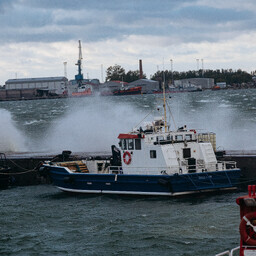Torm Ulla tekitas Soome lahes väga kõrged lained
.
Lained olid kõrgemad kui eelmised suve rekordid
.
Tallinna Tehnikaülikooli seade mõõtis lainekõrguseks 4,1 meetrit
.
Selliseid kõrgeid laineid pole nähtud siin alates 1980. aastast
.
Torm Ulla tekitas Soome lahes väga kõrged lained
Tõlge fraasile: Torm Ulla tekitas Soome lahes väga kõrged lained
EN
Storm Ulla created very high waves in the Gulf of Finland
Lained olid kõrgemad kui eelmised suve rekordid
Tõlge fraasile: Lained olid kõrgemad kui eelmised suve rekordid
EN
The waves were higher than the previous summer records
Tallinna Tehnikaülikooli seade mõõtis lainekõrguseks 4,1 meetrit
Tõlge fraasile: Tallinna Tehnikaülikooli seade mõõtis lainekõrguseks 4,1 meetrit
EN
The device of Tallinn University of Technology measured the wave height at 4.1 meters
Selliseid kõrgeid laineid pole nähtud siin alates 1980. aastast
Tõlge fraasile: Selliseid kõrgeid laineid pole nähtud siin alates 1980. aastast
EN
Such high waves have not been seen here since 1980
Eelmine suve rekord pärineb 2007. aastast
. Siis mõõdeti lainekõrgus 3,7 meetrit. Seekord põhjustas kõrged lained tugev tuul.
Tuulekiirus ulatus 27,1 meetrini sekundis
. Kõik see juhtus Soome lahe kesk- ja lääneosas.
Eelmine suve rekord pärineb 2007. aastast
Tõlge fraasile: Eelmine suve rekord pärineb 2007. aastast
EN
The previous summer record dates back to 2007
Tuulekiirus ulatus 27,1 meetrini sekundis
Tõlge fraasile: Tuulekiirus ulatus 27,1 meetrini sekundis
EN
The wind speed reached 27.1 meters per second
Lainete tekkimiseks on vaja väga tugevat tuult
.
Tuul peab puhuma kindlas suunas ja vähemalt kuus tundi järjest
. Kui tuul on lahe pikkusesuunas, tekivad kõrgemad lained. Kui tuul puhub teises suunas, peab see olema tugevam.
Lainete tekkimiseks on vaja väga tugevat tuult
Tõlge fraasile: Lainete tekkimiseks on vaja väga tugevat tuult
EN
Very strong wind is needed for the formation of waves
Tuul peab puhuma kindlas suunas ja vähemalt kuus tundi järjest
Tõlge fraasile: Tuul peab puhuma kindlas suunas ja vähemalt kuus tundi järjest
EN
The wind must blow in a certain direction and for at least six hours in a row
Tuul oli kõige tugevam Vaindloos
. Seal mõõdeti tuulekiiruseks 30,0 m/s. Soome lahe idaosas olid lained ilmselt veel kõrgemad. Praegu ei ole seal seadmeid, mis laineid mõõdaksid. Sellepärast oleks vaja rohkem seadmeid lainete mõõtmiseks.
Tuul oli kõige tugevam Vaindloos
Tõlge fraasile: Tuul oli kõige tugevam Vaindloos
EN
The wind was strongest in Vaindloo
Lainete kõrgus ei ole ainus oluline asi
. Oluline on ka lainete pikkus.
Öösel olid lained umbes 130 meetri pikkused
. Seetõttu peatasid mõned suured laevad oma sõidud. Lained võivad olla ka kaks korda kõrgemad kui prognoositakse. Seda pidavad arvestama kõik meresõitjad.
Lainete kõrgus ei ole ainus oluline asi
Tõlge fraasile: Lainete kõrgus ei ole ainus oluline asi
EN
The height of the waves is not the only important thing
Öösel olid lained umbes 130 meetri pikkused
Tõlge fraasile: Öösel olid lained umbes 130 meetri pikkused
EN
At night, the waves were about 130 meters long
Väikestele paatidele on ohtlikud juba 0,5 meetri kõrged lained
. Kui prognoos näitab 0,3 meetri lainekõrgust, siis ei tohiks merele minna. Suure tõenäosusega on lained siiski kõrgemad.
Väikestele paatidele on ohtlikud juba 0,5 meetri kõrged lained
Tõlge fraasile: Väikestele paatidele on ohtlikud juba 0,5 meetri kõrged lained
EN
Waves of 0.5 meters are already dangerous for small boats
Töötab ööl on merel raskem navigeerida
.
Väikeste paatide juht peab alati hoidma paati lainetele vastu ja korrigeerima kurssi
.
Töötab ööl on merel raskem navigeerida
Tõlge fraasile: Töötab ööl on merel raskem navigeerida
EN
It is more difficult to navigate at sea at night
Väikeste paatide juht peab alati hoidma paati lainetele vastu ja korrigeerima kurssi
Tõlge fraasile: Väikeste paatide juht peab alati hoidma paati lainetele vastu ja korrigeerima kurssi
EN
The driver of a small boat must always keep the boat against the waves and adjust the course
Storm Ulla created very high waves in the Gulf of Finland. The waves were higher than previous summer records. A device from Tallinn University of Technology measured the wave height at 4.1 meters. Such high waves have not been seen here since 1980.
The previous summer record dates back to 2007. At that time, the wave height was measured at 3.7 meters. This time, the high waves were caused by strong winds. The wind speed reached 27.1 meters per second. All of this happened in the central and western parts of the Gulf of Finland.
Very strong winds are needed for waves to form. The wind must blow in a certain direction and for at least six hours continuously. If the wind is in the longitudinal direction of the gulf, higher waves are formed. If the wind blows in another direction, it must be stronger.
The wind was strongest in Vaindloo. There, the wind speed was measured at 30.0 m/s. In the eastern part of the Gulf of Finland, the waves were likely even higher. Currently, there are no devices there to measure the waves. Therefore, more devices are needed to measure the waves.
The height of the waves is not the only important thing. The length of the waves is also important. At night, the waves were about 130 meters long. As a result, some large ships stopped their journeys. Waves can also be twice as high as predicted. All sailors must take this into account.
For small boats, waves as high as 0.5 meters are already dangerous. If the forecast shows a wave height of 0.3 meters, one should not go to sea. Most likely, the waves will still be higher.
Working at night makes navigation at sea more difficult. The driver of a small boat must always keep the boat against the waves and adjust the course.

